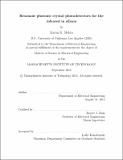Resonant photonic crystal photodetectors for the infrared in silicon
Author(s)
Mehta, Karan K. (Karan Kartik)
DownloadFull printable version (6.728Mb)
Alternative title
Two-photon absorption detection of infrared light in silicon optical resonators
Other Contributors
Massachusetts Institute of Technology. Department of Electrical Engineering and Computer Science.
Advisor
Rajeev J. Ram.
Terms of use
Metadata
Show full item recordAbstract
The challenge of overcoming energy efficiency and bandwidth limitations in interconnects between components in computer systems (e.g. between memory and processors) has motivated the development of short-range optical interconnects, which in many approaches require optical devices and waveguides fabricated within the same CMOS environments as the electronics. This thesis centers on developing photodetectors for infrared light within the silicon of commercial CMOS processes; silicon's lack of strong absorption at the wavelengths of interest makes this challenging. The approach uses defect-state mediated linear absorption and two-photon absorption (TPA) in small mode-volume resonators to generate photocarriers. Such resonators allow efficient linear absorption in short devices despite low absorption coefficients, and a greater TPA rate than in bulk material due to the large energy densities achievable. The devices here are made in the polysilicon layer of a commercial DRAM process, and characterization of this material, different from crystalline Si in both its linear and nonlinear absorption, forms a starting point. The design, fabrication, and testing of electrically addressable photonic crystal resonators subject to the constraints associated with working in a CMOS process are then presented. The best resonators made were able to reach Qs of 70,000, limited by linear loss in the polysilicon. Linear absorption is dominant in the devices made to date, and allowed quantum efficiencies of a few tens of percent on resonance. However, high biases of around -20 V were required to achieve these QEs, and the bandwidth of the devices was limited to only approximately 500 MHz. Improvements to the electrical structure of the devices are likely to improve these characteristics. The ability to fabricate high-Q photonic crystal resonators within full CMOS flows, and the QEs allowed by defect-assisted absorption in the devices measured, indicate promise for this approach to photodetection in integrated CMOS photonic systems.
Description
Thesis (S.M.)--Massachusetts Institute of Technology, Dept. of Electrical Engineering and Computer Science, 2012. This electronic version was submitted by the student author. The certified thesis is available in the Institute Archives and Special Collections. Cataloged from student-submitted PDF version of thesis. Includes bibliographical references (p. [107]-115).
Date issued
2012Department
Massachusetts Institute of Technology. Department of Electrical Engineering and Computer SciencePublisher
Massachusetts Institute of Technology
Keywords
Electrical Engineering and Computer Science.